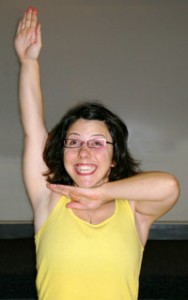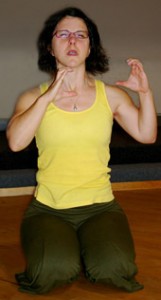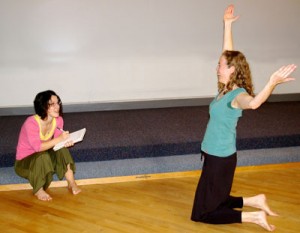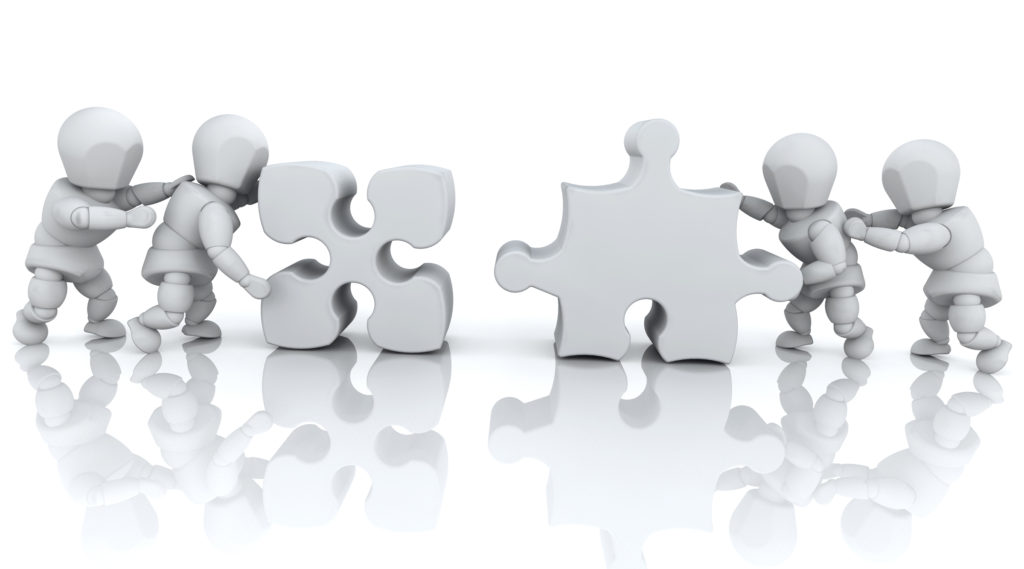Download PDF: Wegner, The Role of Improvisation
ABSTRACT
Our bodies play an essential role in our thinking and learning. However, the educational system we inherited from the scientific paradigm was designed to limit the body’s interaction in learning. In fact, as students progress through the educational system, the needs of the body are increasingly viewed as an impediment to the learning process, rather than an integral part of it. The purpose of this study is to explore the epistemological role that the body plays in helping students to engage in intellectual inquiry. The methodology integrates a review of research literature on brain-based developmental psychology with a phenomenological approach, reflecting on and analyzing the author’s past and present experiences in using improvisation in classroom situations. The analysis suggests that the body is both a storehouse of information and an important thinking agent. Furthermore, animating the body through improvisation releases the imagination and opens the door to a fuller way of knowing that brings together the personal, intellectual, and spiritual into a holistic epistemological framework.
“What would happen if we used the brains in our whole body?”
—Phil Porter, co-founder of InterPlay1
In previous eras of human history, and in some cultures today, the psychic, somatic, and experiential were the privileged ways of knowing. The transition to modernity reversed this status, privileging instead a detached, non-participatory, objective way of knowing. This shift resulted in a discrediting of the knowledge that came from human intuition, imagination, feelings, spirituality, and the body,2 in favor of a knowledge that could be scientifically observed and recorded. Over the last fifty years, there has been a move to integrate both objective and subjective ways of knowing, resulting in a significant paradigm shift in what we consider to be possible and acceptable processes of inquiry. This shift is visible across a number of domains of contemporary life, including academia.
In this paper, I will explore the epistemological role that the body plays in helping students to engage in intellectual inquiry in academic settings. In this context, I define inquiry as a process of engaging and satiating our curiosity by willingly plunging into the unknown, so that something new might become knowable. I suggest that the body is both a storehouse of information and an important thinking agent; furthermore, animating the body through improvisation releases the imagination and opens the door to a fuller way of knowing. Both improvisation and imagination are grounded in the body, and are essential components in the process of what I call body-based inquiry. The questions that will guide this project include: What is the role that imagination and improvisation play in the inquiry process? Practically and theoretically, what is body-based inquiry? To what end might body-based inquiry be utilized in academic discourse? To best engage these questions from the perspective of practical experience, I move now to a pedagogical reflection that arose in my former vocation as a teacher of sixth graders.
* * *
One day in my sixth grade world history classroom, I made a last-minute decision that taught me firsthand about the power of accessing alternative ways of knowing in an academic context. We were beginning to study creation myths, exploring the ways in which people from different cultures and times explained how the world around them came into being. I explained the difference between a scientific theory (an educated guess based on observation and evidence) and a creation myth (a story that may or may not be true that symbolizes the world view, traditions, values, and dreams of a people). Before we dove into reading our first myth, I was suddenly seized with inspiration.
“Grab a partner,” I suggested. “Decide who is going to go first and who is going to go second. Now, the first person has exactly a minute to tell your partner a fake creation myth. Use your imagination and have fun. Try to make up a good reason for how the world got here. And remember, you have only a minute. Ready, set, go!”
Immediately, the classroom was abuzz with excited storytelling. After both partners had taken their turns, we went around the circle, and each person shared a favorite detail from his or her partner’s fake myth. I couldn’t believe my ears! All these imagined stories mirrored, in some way, the details from the myths that we were about to read. I quickly requested that students take notes as we went around, asking them to label the list, “Where Creation Myths Come From.” One girl imagined that the world began with a princess who lived in a tall tower. She let down her hair, and all the new people climbed up her hair into the tower, and that’s how the world became populated. I asked this student how she came up with that story.
“Well, I got it from a fairytale I know already,” she said.
“Fascinating!” I replied. “You’re just like the early people. Some of their creation myths were based on other stories they had heard in their culture. Write this down!” Pencils obediently scratched.
The next student admired her partner’s choice to have God spit out a marble, which became the Earth.
“Where do you think you got that idea from?” I asked her partner, and he responded, “Well, I know that the earth is round, and a marble is round too, so I borrowed that.”
“Aha!” I exclaimed, excited that the exercise was helping students make unexpected connections between their prior knowledge and the lesson content. I quickly pointed out that, just as this student used the symbol of a marble to represent his knowledge of the shape of the earth, so had the early people looked at the surrounding landforms, and created myths based on the shapes that they deciphered in those geographical features. Dutifully, students wrote “geographic shapes” in their notes.
The conversation went on in this manner, as students continued to discover that their imagined myths grew out of their prior experience with the world. We went on to read creation stories from five different cultures, and we found similar elements in all those stories. Students were much more captivated after having discovered that their own stories—imagined in a quick, improvisational activity—were similar, in many ways, to those created by people thousands of years ago.
* * *
Improvisation is, most simply stated, the process of making things up on the spot using only the resources at hand. A central tenet of improvisation is that creativity and freedom emerge from structure. Perhaps counterintuitively, it is the very presence of restrictions that fosters new possibilities. A cook improvises a dish without a recipe, for example, by creatively combining the food available in the refrigerator. A young woman with no time to hem her new pants discovers that duct tape does the trick perfectly. A jazz musician improvises a new riff, building off of his existing knowledge of music, his prior experience playing the trumpet, and the notes and tempos created in the moment by fellow musicians. In all these examples, a constraint on resources becomes a resource in and of itself: improvisation is the act of finding opportunities for creativity amidst limitations.
In the example above, my students were improvising by using the resources they had available to them: the time constraint of one minute, twelve years of experience in being alive in this culture and on this earth, and their lively imaginations. The students had no time to think; instead, they had to speak quickly and pay attention to the words that tumbled out of their mouths. It is precisely when the analytic parts of the brain do not have time to fully engage that deeper storehouses of knowledge can be accessed. Moreover, the students’ twelve years of life experience provided them with an important resource; as individuals live their lives, they gather and store experiences, observations, feelings, and beliefs. Many of these are conscious, many are unconscious, but all are part of our native knowledge,3 which is the accumulated tacit and explicit knowing that comes from lived experience. During the creation myth assignment, in the span of one minute, students’ imaginations were interfacing with their native knowledge to create a fake creation myth. By reflecting on the improvised stories, we were inquiring into the question, “Where do creation myths come from?”
What exactly does it mean that my students were using their imaginations to inquire into something new? Most definitions suggest that imagining is the process of forming mental images of something that is not present to the senses, or that has not been experienced directly. In other words, these definitions propose that imagination gives a mental image to that which does not yet exist. It is the human ability to try on new possibilities for how the world might be. Yet the process of imagining is also inherently improvisational, since the imaginer is creating new possibilities, moment by moment. However, as I will show, imagining is not just an improvisational process for limitless creation; it is also a site where creation takes place (we say something occurs “in the imagination”), as well as a tool for creating something new (we encourage students to “use your imagination”). If inquiry is the process of discovery generated by the willingness to surrender into not-knowing for a period of time, then the act of imagining can also be an inquiry process in its own right.
Improvisation rests on a similar premise, that within the safe structure of a form, improvisers have the freedom to surrender what they think they know, and to discover the surprises offered when their imaginations interact with the resources available. Improvisation can serve, therefore, as a form of inquiry, in that new knowledge unfolds during the course of the improvisation. In this context, imagination, improvisation, and inquiry have certain commonalities. All are generated, firstly, by a willingness to surrender to the unknown; all are characterized, secondly, by an unfolding of new possibilities; thirdly, all have the potential to release an individuals’ native knowledge; and finally, all can be generative forces for creating something new.
* * *
In the short activity that I led with my students, we used improvisational storytelling to activate our imaginations and to inquire into the sources of creation myths. The activity was completely verbal, accomplished while sitting around a table. What might an inquiry process look like if the body were freed to express itself more fully? What knowledge might be released if we were to engage our whole bodies—and not just our voices—in the process of imagining?
Cognitive science has much to teach us about the relationship between the body and the human ability to think and imagine. Lakoff and Johnson define cognition as any mental operations and structures that are involved in language, meaning, perception, conceptual systems, and reason. Because our conceptual systems arise from our bodies, we will also use the term cognitive for aspects of our sensorimotor system that contribute to our abilities to conceptualize and to reason.4
Simply stated, then, cognition is a mental and physical process that is involved in communicating, perceiving, imagining, reasoning, and conceiving. Significant to this definition is the understanding that our bodies do not simply help with cognition; they are an integral, and in fact a foundational, part of these processes. The child development psychologist Jean Piaget was perhaps misguided when he suggested that, as people get older and develop higher-level cognitive abilities, their thinking abstracts away from sensorimotor action. Although it is true that in our youngest years, our development is centered on movement and the senses, it is not true that our cognition becomes less reliant on these sensorimotor functions as we think with more complexity. A growing amount of research in cognitive science disproves the idea that the body is merely a building block to higher cognitive capabilities; rather, this research suggests that cognition involves a constant reciprocity between our somatic and mental capabilities.5
From a physiological standpoint, it is actually difficult to distinguish between the somatic and the cognitive. We learn because we have complex networks of neuronal pathways that stretch throughout the entire body. As our neural networks grow, they form base patterns. These configurations “provide a framework of information from which new nerve networks elaborate to increase our understanding and abilities through life.”6 The more neural pathways we develop, the more we are capable of learning. Similarly, the more interaction our bodies have with the environment around us, the more neural pathways we establish. Therefore, from the standpoint of physiology, learning is accomplished through experience, and experience is comprised of recurring patterns in our body’s ability to move and perceive in the context of our environment.
Indeed, every time we experience new ideas and situations, our brain remodels itself, creating more complex neural networks throughout the body. In fact, Lakoff and Johnson suggest that “an embodied concept is a neural structure that is actually part of, or makes use of, the sensorimotor system of our brains. Much of conceptual inference is, therefore, sensorimotor inference.”7 And if this is the case, then our ability to use our imagination, which is mostly conceptual in nature, must also be linked closely to movement and the senses. Research shows that axons, which are the nerve fibers that conduct electrical impulses to the brain, conduct a large number of impulses from areas in the brain associated with movement to areas associated with cognition. In other words, axons that move from movement-controlling areas of the brain to cognition significantly outnumber the axons that move from cognition to movement.8 Thus, there are important neural connections between body and mind, and movement and thinking are inescapably linked.
The more scientists study the brain, the more they discover increasing connections between imagination and movement, emotion and learning, sensory experience and cognition, and vocal utterance and abstract thinking. Indeed, this connection between the mind and the body, between thought and physicality, is best summarized by Gibbs, who synthesizes an impressive amount of research surrounding the relationship between the body and cognitive science. He calls this synthesis “the embodiment premise,” which I have transcribed here in its entirety:
People’s subjective, felt experiences of their bodies in action provide part of the fundamental grounding for language and thought. Cognition is what occurs when the body engages the physical, cultural world and must be studied in terms of the dynamical interactions between people and the environment. Human language and thought emerge from recurring patterns of embodied activity that constrain ongoing intelligent behavior. We must not assume cognition to be purely internal, symbolic, computational, and disembodied, but seek out the gross and detailed ways that language and thought are inextricably shaped by embodied action.9
For Gibbs, then, the lived experiences of our bodies moving through space are so completely intertwined with cognition that it is impossible to separate somatic and mental processes. Cognition—and the associated tasks of imagining, inquiring and improvising, which are the subject of this paper—are, in fact, dependent on our kinesthetic experience of our bodies in action. We can literally think more effectively and imaginatively when we move our bodies.
* * *
Three years ago, when I set out to write my thesis for my master’s degree in education, I had not yet been exposed to this research. As a teacher of social studies at the secondary school level, I was much more compelled to explore the ways in which I might incorporate spirituality, meaning, and wholeness into standard history curricula. However, the deeper I delved into literature that addressed spirituality and education, the more captivated I became by the role the body plays in the meaning-creation process. Soon I had devised the term “body-based inquiry” to define the process by which we make conscious the body’s cognitive wisdom through engaging in and reflecting on a variety of somatic practices. I also realized that it was not enough to simply study body-based inquiry as a concept; I would also need to practice body-based inquiry as one of my research modes.
To this end, I invited friend and fellow graduate student Katherine Kunz to meet with me in a dance studio once a week, to use improvisation as a means for shedding new light on our thesis topics. Katherine was also working on a thesis about the intersections between spirituality, improvisation, and the body. Recently, we had both been trained in the art of InterPlay, which provided a shared language of improvisational forms. It was especially useful that InterPlay’s philosophy [pagebreaks]is intentionally rooted in the intersections between spirituality and the body. The InterPlay forms thus became the main language of inquiry during our sessions together.
Interplay is a system of ideas and practices that helps to unlock the wisdom of the body. It is an art form grounded in accessible and playful exercises, incorporating storytelling, movement, singing and stillness. Co-founders Phil Porter and Cynthia Winton-Henry have devised a uniquely systematized and incremental approach to helping participants get “body, mind, heart, and spirit working together again.”10 The InterPlay website goes on to explain:
InterPlay reconnects us with the wisdom of our bodies – what we know from paying attention to our own experience. We are often cut off from that wisdom by the expectation of others, by external authorities, by fear or repression. InterPlay is rooted in creating, in looking for the good, in play. The InterPlay atmosphere is one of ease and fun, rather than struggle. We gain huge insights from the simplest of activities—learning through playing—and regain confidence in our ability to respond in the moment.11
Simple exercises (known as forms) ease participants into an embodied play experience. Often, the forms release insight. Although participants are not explicitly asked to look for deeper connections among their personal, spiritual, social, and political lives, the forms easily elicit such reflection. In other words, moving the body improvisationally has the potential to open up surprising content that is often profoundly connected to the sources of meaning in people’s lives. I have often heard participants exclaim, “I haven’t thought about that memory in ages!” or, “I didn’t know I knew that!” These exclamations, which I too have uttered in the midst of InterPlay classes, reveal the delight that participants experience when their native knowledge surfaces; the insights are usually deeply moving and startlingly illuminating. In the context of my thesis research, I anticipated that the InterPlay forms would be useful in unlocking my innate intuition about my academic questions. Unanticipated, though, was how intimately and intricately my personal and intellectual lives blended, and the surprising directions that my research would take as a result of this body-based inquiry practice.
When Katherine and I met every Tuesday morning, we used the three main InterPlay forms – storytelling, movement, and vocalization – as the foundation for our experiment. Often we would engage in “babbling,” a storytelling form which involves talking nonstop about a subject for a short amount of time, usually from thirty to sixty seconds. For example, when I had my sixth graders create fake creation myths, I was making use of InterPlay’s “babbling” form, inasmuch as I asked them to limit their discourse to a minute, and encouraged them to articulate whatever ideas arose in their minds.
Other times, Katherine and I would create improvisational movement pieces inspired by a concept or question that had emerged in our library research that week. We would “babble” while we simultaneously animated our entire bodies, blurring the line between storytelling and dance in an InterPlay form called “the big body story.” Sometimes we would speak in gibberish; other times we would incorporate singing or vocalized sound. It is important to note that we never choreographed our pieces ahead of time; rather, we arrived with words, concepts, and questions that we wanted to unpack in more depth through this exploration of physical movement and sound.
Although it is often difficult to imagine the InterPlay forms without experiencing them directly, it may be helpful for the reader to have a more concrete mental image of my process with Katherine. The following entry, an excerpt from the journal I wrote during my sessions with Katherine, paints a more detailed picture of what body-based inquiry looks like in action.
* * *
March 14, 2006.
Today Katherine and I got together for our first exploration of how the practice of InterPlay (specifically) and embodiment (generally) might support us in the process of writing our respective theses. What a sweet space we have created for ourselves already! She is a student at Pacific School of Religion in Berkeley, and so we were able to use a dance studio there. After tea and brainstorming about what we each hope to accomplish through this time together, we gathered in the studio to begin to play.
Warm-up first, separately, to music. Then some babbling to get our words warmed up after our bodies. Then I proposed big body stories in gibberish (a string of nonsensical words and sounds) to complete the sentence “My thesis is about…”. The gibberish seemed important because I was worried that we would both go too quickly into our heads if we started talking about our ideas in words.
It always feels like a mini-adventure, to step out into the stage space and start moving and speaking without knowing exactly what will happen. I’m not sure how to describe the beautiful piece that eventually emerged from my body, so I’ll try describing it in the genre of poetry:
My lungs fill fully, deeply, and then air releases:
Blowing upward, out of me, downwards, over me,
Spirit.
Then:
Sitting cross-legged, straight-backed, on the floor.
Hand goes up, straight up, like a pistol. Eyes hopeful. See me, teacher, see me!
I answer the question perfectly (in gibberish, of course).
I smile; beam; screech my joy at getting it right.
But then:
Back of my hand pushes my chin upwards, up, up.
Don’t look down! Don’t see heart!
Stay in head. Stay in approval.
But . . . I . . . want to see . . . hear . . . heart!
NO!!! Heart is hidden. Another hand blocks head from heart.
I have been dissected.
But then:
In pantomime,
Hands grasp the huge, rectangular, leaden block that has lodged in my throat.
Pull, pull.
The block resists, resists.
Growl, grunt, pull – there! It is gone!
So then:
Freedom. No need to notice where heart is, where head is.
It’s all one, connected;
Body leaps and swirls, mouth opens, sounds come out –
Not the sounds of before, the “How might I please you?” screeches.
This time singing sounds, resonant, pretty, pouring out, sliding along the scale.
Body follows voice follows body, until . . .
Belly on the ground, arms and legs splayed out,
Opposite of uptight and scrunched, folded into a desk.
Now: out, messy, contact with the floor; grounded
Potential to rise, move, listen, learn, love,
Or just to lay, chest heaving, bodyspirit satisfied
Against the earth, my home.
This is what my thesis is about.
“What did you notice?” Katherine asked afterwards. I noticed frustration, first, that no new ideas had come from my story. I wanted revelation, bold and easy to identify; I was hoping for a new, brilliant idea, never thought before, that would bring the whole thesis together. No, there wasn’t that. But there was so much more. There was the image of removing the block from my throat, and then the feeling of freedom that comes after we make space for the messy connections between mind, body, and spirit. The memory, too, of how beautiful it sounded when I trusted my voice to open and open and sing and sing. The voice is part of the body, I realized (perhaps this was the revelatory idea), and when we tell students to “be quiet” or “don’t talk” or “don’t talk so loud,” we impede this important link to their fuller selves.
So what? Why is all this movement helpful? Can’t I write a thesis without this? Isn’t it frivolous, to gather once a week with Katherine to play? Well . . . I noticed that afterwards, I felt energized, excited to sit at the computer and see what I might write. There hasn’t been the usual struggle to write; instead, inspiration and motivation. Not inspiration to write a specific content, but more of an excitement about the process of writing. I feel relaxed, like my body is a part of the all of me, and has much to contribute to my inquiry.
* * *

This description from my journal reveals the ways in which improvisation, imagination, and inquiry combined to create an intellectually, emotionally, and spiritually rich experience for me as a learner. The big body story that I improvised was especially powerful because it enabled me to picture myself more fully, to see more clearly the intersections between my academic inquiry, my personal experience, and my fundamental beliefs. In fact, I didn’t just see these intersections; I embodied them in a surprisingly articulate movement metaphor that is now permanently inscribed in my muscle memory. The images that I embodied, of the student who seeks approval and is disconnected from the messages of her heart, are deeply personal images of my own former relationship to my schooling. The removal of the symbolic lead block from my throat represents my desire to help students integrate their full sense of self into their learning. It also points to the ways in which the writing of the thesis had removed an important block from my own voice. I began the big body story with the intention of learning more about my thesis; I ended the story having discovered how deeply personal, and also transformational, the research and writing process could be. The improvisation allowed me to articulate a central source of meaning in my life – the drive to find wholeness and to integrate parts of myself that had previously been separated. In this way, I discovered that my intellectual and spiritual pursuits were intricately connected. This realization was facilitated by the simple use of movement, storytelling, and sound to make my subconscious thoughts visible in the improvisational space.

Among the InterPlay community, this experience is hardly new; for 25 years, InterPlayers have enjoyed the “aha!” feeling that often comes after playfully engaging in the improvisational forms. More recent, however, is the research from cognitive science that suggests why whole body improvisation can be such an integrating and insightful experience for many people. Earlier in this essay, I cited research that suggests that movement influences cognition significantly more than cognition influences movement. When the body moves, it is more than just muscle work; the cerebellum is in high gear. Given that the cerebellum is the place in the brain that has also been linked to “memory, spatial perception, language, attention, emotion, nonverbal cues, and decision-making,”12 our movement has a direct affect on all of these cognitive processes. In light of this information, is it any surprise that my big body story elicited a combination of knowledge, memories, and insight?
Research also suggests that the body and its activities are intricately woven into human beings’ thought structures and conceptual frameworks. As Gibbs explains, “[m]any of our embodied experiences are incorporated into our conceptual and linguistic representations. Moreover, our phenomenological bodily experiences continue to reaffirm and ground cognitive symbols.”13 A cognitive symbol is anything that represents a thought, without being the thought itself, such as words, images, and metaphors. Perhaps one reason that my big body story proved so useful to my research was that I was improvising embodied cognitive symbols that illuminated, upon later reflection, an intellectual understanding of the concepts. The pantomimed lead brick that I removed from my throat gave me a concrete image of the barrier that often exists between emotions and the intellect. I did not plan to symbolize this barrier, nor had I until this moment articulated that this barrier existed. However, once the image emerged, it became immediately clear that this split between head and heart was simultaneously a personal reality, an arena for spiritual healing, and a theoretical direction to investigate in my research. Through improvisation, my native knowledge became visible, and provided a concrete, embodied symbol that I could interpret through intellectual and personal lenses. Furthermore, the act of physically expressing this cognitive symbol permanently inscribed it into my body memory. I can remember in vivid detail what it felt like to tell the story. In fact, when I invited Katherine to read the drafts of this article, she too was surprised by how vividly she remembered the content of my story. The performative aspect of InterPlay allows for a strong transmission of the symbols to the witness, not just to the performer.
So far, I have discussed the ways that body-based inquiry methods reveal the overlaps in both personal and intellectual sources of meaning. Yet it is also helpful to look at the specific ways in which my experiment in embodied discourse helped both Katherine and me in the process of writing our theses. Both of us reported increased energy around our research as a result of these weekly sessions. If my motivation to read and write was dragging before meeting with Katherine, I was especially productive afterwards. Interestingly, these sessions helped me to feel as if I had an intimate relationship with my work. In fact, there were days when I heard myself telling friends, “I need to go make love to my thesis for a while.” Although it is true that I was passionate about the topic, that passion was amplified by the weekly opportunity to play in an embodied and imaginative way with ideas that were otherwise abstract and impersonal. Katherine also reported that she often came to the sessions feeling “stuck” about how to make connections among diverse ideas, but the InterPlay forms allowed an easeful way to imagine possible connections without feeling the pressure to be “smart” or to get it “right.” Both of us reflected, too, that the community aspect was crucial. “Putting my ideas out in the community grounds them and gives them substance,” Katherine said, adding that it was also nice simply to know that someone was available, cared, and noticed what she was thinking.14
Furthermore, the opportunity to be witnessed while performing a piece excused both of us from the pressure to generate ideasand to document them at the same time.15 For example, because Katherine knew that I was witnessing her work, she could relax and enjoy the process of idea generation, trusting that I was documenting her process as she talked. The presence of a witness also allowed each of us to “hear what we said in a new way.”16 After I witnessed a big body story by Katherine, I repeated back to her the order of ideas as she had improvised them. Hearing me repeat her thoughts out loud helped Katherine to understand the flow of her own ideas, confirmed her inner authority17 about the topic, and eventually created a layout for the table of contents for her thesis.

It is important to note that most of the time during our sessions, neither of us experienced an “aha!” moment that offered immediate new insight. However, I would often experience moments of sudden insight soon after our meetings. Both Katherine and I reported noticing a deep integration of our ideas after we left the play space. It appears that one gift of whole-body, imaginative improvisation is that it shakes up our initial conceptions of what we “know”—both the internal knowing referred to here as native knowledge, and the external knowing that we have gleaned from other, so-called “expert” sources. It takes time, however, to let our various ways of knowing fall back together in surprising ways. The process of reflecting on our improvisations, both verbally and in writing, was crucial in helping the chaotic experience of play settle into articulate insights. It was extremely helpful to move between imaginative embodiment, silent writing, and verbal reflection—and then provide time away from the sessions for our conscious minds to integrate it all.
* * *
From an empirical standpoint, our bodies are an essential part of our thinking and learning. It is also true that the educational system we inherited from the scientific paradigm was designed to limit the body’s involvement in learning. Classrooms that cater to this paradigm still keep students [pagebreaks]in desks which are aligned in straight rows; students may not move or speak unless they receive permission; the classroom provides very little in the way of sensory stimuli; emotion, particularly expressed emotion, is unwelcome; and experience occurs in the mind rather than in the environment. Of course, not all classrooms these days are so restrictive, but it is safe to say that most school- and university-based learning situations regard the needs of the body as an impediment to, rather than an integral part of, the learning process. When we consider the extent to which freeing the body also frees the imagination, then we see how classrooms at all levels access only a small fraction of a person’s knowing potential. Although this is true of schooling at all levels, it becomes increasingly true as students progress through secondary schooling and into higher education. This means that as most students progress through our educational system, their ability to access all of their knowledge is increasingly limited.
In contrast, as I have worked to show here, the body can play a significant role in learning and inquiry processes. The improvisational learning activities mentioned in this paper—fake creation myths and big body stories—all point to the power of accessing body-based ways of knowing in order to unpack complex, abstract concepts. Improvisation-based imaginative exercises are not just fun, they are an effective and efficient way of uncovering our native knowledge, and making our thoughts visible. Body-based inquiry practices do more than just inform our understanding of the content we are exploring; they have the potential to unveil the connections between academic content and the deeper, intuitive sources of meaning in our lives. Improvisation stirs up what we know about a subject, evoking seemingly hidden and unconnected worlds of thoughts and bringing them together in new and exciting ways. Furthermore, the insights that bubble up when bodies interact with their surroundings are largely interdisciplinary in nature, connecting the personal, the intellectual, and the political in surprising ways that might have lain dormant within just a head-oriented approach to the investigation. Finally, as I discovered so powerfully, body-based processes uncover powerful symbols and metaphors for our ideas, which in turn inspire the imagination to engage more creatively with the topic at hand.
So what does all this mean for academia? It is now time to investigate the implications for how, and to what end, body-based inquiry might be utilized in academic discourse. I introduced this paper with a question from InterPlay’s cofounder, Phil Porter: what would happen if we used the brains in our whole body? This is a question that requires more than a simple answer; rather, this question must be lived into continuously, in the way that Rilke urges in his famous poem.18 What would happen – for individuals, for groups, for the global community – if humans consistently paid attention to, and acted from, the wisdom in their own bodies? Because my scope of interest is the field of education, I am curious about how educators and students might teach and learn from a place of holistic integration that brings together body, mind and spirit. As I see it, there are implications in at least three different domains: in specific academic disciplines, in classrooms, and in research.
Body-based inquiry methods invite us to continuously question and expand our understanding of epistemology and what it means to “know” something. Specific disciplines within academia have their own philosophies and practices, not only about how knowledge is constructed, but also about how meaning is created. Experts in both the sciences and humanities might consider the body’s role according to their own epistemological frameworks, including these queries adapted from Heshusius and Ballard19: How does your discipline contribute to an understanding of how human beings might live in and talk about an embodied reality? Furthermore, how might your discipline foster an embodied reality in its modes of discourse? These questions help scholars in the academy to address, according to Nika Quirk and Shoshona Simons, “the gap between our everyday ‘life performance’ as writers, researchers, educators, and practitioners, and the continuing expectation [from our disciplines] that we speak and write in restrictive tongues.”20 As scholars begin to articulate the role of body-based inquiry in their own disciplines, they will then be able to engage more deeply in interdisciplinary conversations around holistic epistemology.
The questions about embodied discourse are not just provocative within and among specific disciplines; they are potentially transformative at the level of the classroom, where the academy’s body of knowledge is (re)created and disseminated. Progressive and holistic educators and brain-based learning experts have done much in recent years to prioritize the role that experience plays in teaching and learning, and to advocate for learning activities that are as hands-on and experiential as possible. Although the literature in this area is more extensive for school-age classrooms, some experiential learning practices have made their way into the university setting as well. In most of the literature that advocates a holistic approach to elementary and secondary curricula, there is only a patchy understanding of practical methods that incorporate the body’s learning potential into classroom practice. The body is understood as an object that, when utilized properly, can improve students’ learning; however, very few sources in educational literature view the body as a subject that thinks in its own right. More can be done to provide teachers with specific pedagogic tools that invite the body – or rather, the whole person, including the body – to be an equal partner in teaching and learning.
Another implication of this research for teaching is that, as we expand what it means to “know” something, we are also expanding our understanding of the place in which people learn. When the body-as-subject is invited into the conversation about pedagogy, it becomes clear that the classroom is a limited playground for knowledge creation. What if, as students grow older, the tools of inquiry are placed more squarely in their hands? What if, for example, students in university settings created playgroups for themselves, to use the tools of body-based inquiry to expand their own understanding of what they are learning? Recently, I facilitated a 3-month InterPlay group for graduate students who were either preparing their proposals or writing their dissertations. Student participants reported increased wellbeing and productivity, and I learned a great deal about the incremental steps needed to teach students to reflect on their research in this new way. Over the long term, I envision graduate students facilitating embodied discourse by creating their own support groups that use accessible improvisational arts processes to investigate their research questions.
This leads to a final domain in which body-based inquiry might foster new possibilities: research. Over the last ten years, the body’s role in research has become a more prominent focus of qualitative inquiry practitioners. In the few years since I coined the term “body-based inquiry,” scholarship in this area has increased considerably, including the publishing in 2008 of The Handbook of the Arts in Qualitative Research. Although not every chapter in this lengthy tome relates specifically to the role of the body in knowledge construction, the body is nevertheless recognized as a central feature of most arts practices. Arts practitioners have been among the first to look closely at the overlap between critical inquiry and body-based ways of knowing. The preface of the Handbook discusses the significant role the arts play within social science research of opening up “possibilities for alternative perspectives, modes, media, and genres through which to understand and represent the human condition.”21 It is significant that arts-based inquiry methods simultaneously help researchers inquire into as well as representthe human condition. The arts do not only provide an alternative method through which to investigate research questions; they also provide an alternative form for presenting what is discovered. In this way, arts-based processes “give rise to definitions of research form and representation of process, spirit, purpose, subjectivities, emotions, responsiveness, and ethical dimensions of inquiry.”22 As more scholarship is produced in this arena, it is my hope that frameworks will be created to support researchers across the academy as they investigate their questions with increasing attention to holistic ways of knowing.
Finally, a word needs to be said about the importance of fun and play in all levels of education and research. The human spirit craves play, and too often in education we sacrifice play for the serious work of research and writing. A side-benefit of body-based inquiry practices is that they are often fun to engage in. Of course, people have their own beliefs about what feels like “play” and what feels like “work,” and it is faulty to assume that all inquirers would enjoy the embodied, imaginative processes I have described here. However, more can be done to research the role of improvisation and play in learning, especially within secondary and higher education. The invitation for educators to engage in body-based inquiry is really an invitation to play more fully in our classrooms and learning processes. The more we invite multiple ways of knowing into our learning communities, the more we free people up to be themselves, and to engage learning objectives from their own unique perspectives. This can’t help but create powerful new directions in helping intellectuals to live lives of playful meaning and purpose.
Featured image: “Solving Jigsaw Puzzle by Yoel Ben-Avraham. CC BY-ND 2.0
Notes:
- Phil Porter, Having It All: Body, Mind, Heart, and Spirit Together Again At Last(Oakland: Wing It! Press, 1997), 19.
- Louis Heshusius & Keith Ballard, “How Do We Count the Ways We Know? Some Background to the Project,” in From Positivism to Interpretivism and Beyond: Tales of Transformation in Educational and Social Research(New York: Teachers College Press, 1996), 1-16.
- The phrase “native knowledge” comes from the recent work of Nika Quirk and Shoshana Simons, who teach a body-based workshop for academic writers during which they “use creative and performative arts processes to facilitate a re-membering of the native knowledge that lives within our individual and collective bod(ies).” Quirk and Simons draw their underlying theory from a new paradigm emerging in qualitative research, and they draw on arts-based practices that include, but are not limited to, InterPlay. http://www.letthebodyspeak.com(accessed on October 2, 2008).
- George Lakoff and Mark Johnson, Philosophy in the Flesh (New York: Basic Books, 1996), 12.
- Raymond W. Gibbs, Embodiment and Cognitive Science(New York: Cambridge University Press, 2006).
- Carla Hannaford, Smart Moves: Why Learning is Not All in Your Head(Arlington: Great Ocean Publishers, 1995), 27.
- Lakoff and Johnson, 20.
- Eric Jensen, Teaching With the Brain in Mind(Alexandria: Association for Supervision and Curriculum Development, 1998), 86.
- Gibbs, 276.
- InterPlay, “Homepage,” http://www.bodywisdom.org(accessed on September 18, 2008).
- InterPlay, “Frequently asked questions,” http://www.interplay.org/faq.asp(accessed on September 18, 2008).
- Jensen, 84.
- Gibbs, 238.
- Katherine Kunz, 2 May 2006, personal communication.
- A central element of all InterPlay experiences is the role of the witness. At its simplest, witnessing is about paying attention while one or more people are engaged in the forms. It is not about judging the aesthetic production or the content of the other person’s work; rather, it is an opportunity to see others as they are, as well as to notice what you enjoy about their presence. From the performer’s point of view, “having someone witness what we create can provide new levels of information and awareness. The witness provides a structure or framework for what we do, a defined time and place. The witness can also provide a level of accountability, it can help us focus on our own intentions, and it can just be a delight to have someone who is paying attention to us for a few moments!” Phil Porter and Cynthia Winton-Henry, “Self Study for Level Two of the InterPlay Leadership Progam” (partial draft of manual, Body Wisdom Inc., 2008), 26.
- Kunz, personal communication.
- In the InterPlay context, the phrase “inner authority” refers to an individual’s ability to trust the truth of his or her own experience. According to Porter, one of the most important tasks in understanding our own physicality involves learning to tell the difference between what others have taught us and what we have learned from our own experience. Using improvisation in an academic context helps confirm students’ own experience as it relates to the content being explored. Phil Porter, Having it All: Body, Mind, Heart and Spirit Together Again At Last (Oakland: Wing it Press, 1997), 29-33.
- Rainer M. Rilke, Letters to a Young Poet, trans. N.D. Hertner Norton (New York: W.W. Norton, 1993), 34-35.
- Heshusius and Ballard, 10.
- Quirk and Simons.
- J. Gary Knowles and Ardra L. Colep, preface to The Handbook for the Arts in Qualitative Research (Thousand Oaks, California: Sage Publications, Inc. 2008), xii.
- Knowles and Colep, xii.






